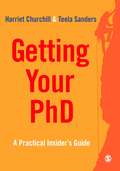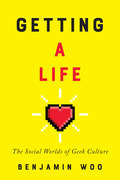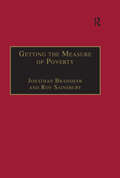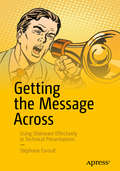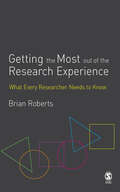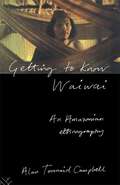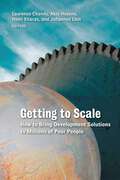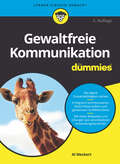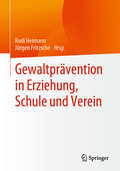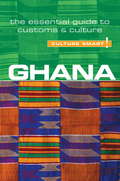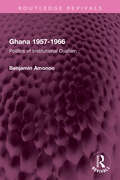- Table View
- List View
Getting Your PhD: A Practical Insider's Guide
by Teela Sanders Harriet Churchill`Getting your PhD will no doubt establish itself as a firm favourite' - ESCalate `Packed with practical advice on all aspects of the PhD process, new and continuing research students should find this book of great help' - Professor Malcolm Tight, Lancaster University, UK How to get your Ph. D is an original study guide aimed at prospective and current postgraduate students, covering the process of accessing, undertaking and completing doctoral research in the social sciences and the humanities. The content is unique in incorporating discussion of the less recognised personal, emotional and organisational demands of independent study. Drawing on a variety of student experiences, the authors apply a case study approach to examine the dilemmas and complexities of postgraduate study. The book is organised into four parts covering the research process; writing, publishing and networking; shifting identities and institutions and relationships of support. Each chapter includes an easy to use format including real-life accounts, tips and strategies for problem solving and guidance for additional resources. The guide includes accessible advice and guidance across a spectrum of methodological, personal, emotional, practical and institutional issues.
Getting a Life: The Social Worlds Of Geek Culture
by Benjamin WooComic book superheroes, fantasy kingdoms, and futuristic starships have become inescapable features of today’s pop-culture landscape, and the people we used to deride as “nerds” or “geeks” have ridden their popularity and visibility to mainstream recognition. It seems it’s finally hip to be square. Yet these conventionalized representations of geek culture typically ignore the real people who have invested time and resources to make it what it is. Getting a Life recentres our understanding of geek culture on the everyday lives of its participants, drawing on fieldwork in comic book shops, game stores, and conventions, including in-depth interviews with ordinary members of the overlapping communities of fans and enthusiasts. Benjamin Woo shows how geek culture is a set of interconnected social practices that are associated with popular media. He argues that typical depictions of mass-mediated entertainment as something that isolates and pacifies its audiences are flawed because they do not account for the conversations, relationships, communities, and identities that are created by engaging with the products of mass culture. Getting a Life combines engaging interview material with lucid interpretation and a clear, interdisciplinary framework. The volume is both an accessible introduction to this contemporary subculture and an exploration of the ethical possibilities of a life lived with media.
Getting by in Europe's Urban Labour Markets: Senegambian Migrants' Strategies for Survival, Documentation and Mobility (IMISCOE Dissertations)
by Inge NieuwenhuyzeThis book examines two major social changes experienced by European cities in the last two decades: post-industrial economic restructuring and new immigration flows. The link between both has been extensively discussed throughout a variety of theoretical approaches and in numerous descriptive contributions. Adding to those studies, this research focuses on three elements of migratory experience that have been relatively neglected thus far: a dynamic view of changes over time, the influence of national welfare and legislation frameworks, and the importance of support mechanisms outside the labour market. The material underpinning the arguments is the qualitative life-course analysis of 81 in-depth interviews with Senegambian migrants living in Antwerp and Barcelona.
Getting from Twenty to Thirty: Surviving Your First Decade in the Real World
by Mike EdelhartThe decade between ages twenty and thirty is one of the most pivotal in our lives. We leave home, we find jobs, we marry. We lose old friends and make new ones. The decisions we face during this time—from where we choose to live to what career we choose to follow—are often made with little more guidance than the advice of a well-meaning (but equally uninformed) friend.We need experience-based advice and empathetic counsel for dealing with our complex and changing world. That&’s what Getting from Twenty to Thirty is all about.Divided into three sections—Breaking Away, Remaking Your World, and Arriving in One Piece—this invaluable book deals with everyday problems without losing sight of our loftier ideals and more permanent concerns. At a time when money is tight, jobs scarce, and our expectations those of a more privileged era, here is sound economic, social and psychological help for a new generation.
Getting the Measure of Poverty: The Early Legacy of Seebohm Rowntree (Studies in Cash & Care)
by Jonathan Bradshaw Roy SainsburyA collection of papers with an historical theme, representing a fundamental review of 'A Study of Town Life' and its impact on the study of poverty and on wider empirical research.
Getting the Message Across
by Stéphane FaroultCreate memorable presentations on technical and complex topics in slideware such as Microsoft PowerPoint and Apple’s Keynote for Mac. Learn good pacing and rhythm as well as judicious use of special effects.Whether the goal is to help a sale or to educate, and whether the final delivery is a live presentation, a webinar, or a short video presentation, this book focuses on the particular difficulties linked to technical presentations. You will learn to create a story when there is none, gain the interest of an audience who may not feel as strongly for the topic as the speaker does, turn abstract concepts into visual models, overcome the limitations of the medium (limited space, two dimensions), maintain interest through rhythm, and use effects, not to look cool or get that "WOW" moment, but to serve the message.Getting The Message Across presents a number of field-tested ideas for raising interest. The use of various techniques and careful scripting will help you, even if you aren't a natural-born show-person, to communicate effectively, and to make your audience remember your message, and not necessarily your slides. This book will teach you:Rhythm and animations, and the use of transitionsTo hold audience interest even with "dry" topicsTo create memorable presentationsTechniques useful for PowerPoint, Keynote for Mac, and any similar presentation medium or environmentWhat You Will LearnTurn austere topics into interesting stories.Give rhythm and pacing to your presentations.Build a narrative during transitions and animations.Hold audience interest and make listeners feel clever.Make people remember your presentation rather than your cool use of slideware.Who This Book Is ForPeople who have to communicate effectively on strongly technical topics. This book targets educators and trainers as well as technical consultants who need to present complex solutions to customers or leads, as well as would-be speakers at scientific or technical conferences. Getting The Message Across is a book for people who want to make their presentations not only more attractive, but really memorable. It is for people who aren't looking for a standing ovation, but who are willing to do what they can to be understood and to make their messages remembered. Getting The Message Across focuses on using slideware such as PowerPoint and Keynote. Such slideware, for all its flaws, is still one of the best ways to communicate, not only live, but also in dematerialized communications (webinars, video tutorials) for reaching an ever-growing audience.
Getting the Message: News, Truth, and Power (Communication and Society)
by John EldridgeThe work of the Glasgow Media Group has long established their place at the forefront of Media Studies, and Getting the Message provides an ideal introduction to recent work by the Group. Contributors discuss themes such as the relationship between the media and public opinion, the emergence of TV news formats and styles, and the relations between theory and method in media research. Recent work undertaken by the Group on the media's role in reporting on AIDS, Vietnam, Northern Ireland and the Gulf War is also represented. In its fresh approach to the relationship between journalists and their sources and occupation analysis, the collection also illuminates how the earlier work of the group has been extended, and the ways in which its research has developed both individually and collectively. Getting the Message offers an invaluable and far-reaching exploration of the inter-relations between the production of media messages and their reception - an invaluable guide for any study of the development of media theory.
Getting the Most Out of the Research Experience: What Every Researcher Needs to Know
by Brian E. Roberts'The book gives a comprehensive overview of what research and the research experience encompass....This book makes an interesting read for everyone who has carried out qualitative research or is planning to do so in the future. It is well-written, and very clearly structured' - Social Research Association While each research situation is different and no book can fully prepare the researcher for what they experience - this book provides a guide to what may be expected. Brian Roberts takes the researcher through the research process, answering the practical and subjective questions anyone will face: - entering the field and finding the right research topic - emotional and identity issues of research - overcoming writing and research 'blocks' - getting your research into reports, articles and books - reactions to research and how to handle experiences of rejection - and the questions every researcher should ask: What do I get from research, and what next? Loaded with advice on everything from organizing interpretations to coping with stress, this book is a must-read for students of all levels across the social sciences who are about to enter the research field.
Getting the Runaround: Formerly Incarcerated Men and the Bureaucratic Barriers to Reentry
by John M. HalushkaGetting the Runaround takes readers into the bureaucratic spaces of prisoner reentry, examining how returning citizens navigate the "institutional circuit" of parole offices, public assistance programs, rehabilitation facilities, shelters, and family courts. Drawing on three years of ethnographic fieldwork and forty-five in-depth interviews with formerly incarcerated men returning to New York City, John M. Halushka argues that the very institutions charged with facilitating the transition from incarceration to community life perversely undermine reintegration by imposing a litany of bureaucratic obstacles. This "runaround" is not merely a series of inconveniences but rather an extension of state punishment that exacerbates material poverty and diminishes citizenship rights. By telling the stories of men caught in vicious cycles of poverty, bureaucratic processing, and social control, Halushka demonstrates the urgent need to shift reentry away from an austerity-driven, compliance-based framework and toward a vision of social justice and inclusion.
Getting to Know Waiwai: An Amazonian Ethnography
by Alan CampbellLiving with the Wayapi, and their charismatic leader Waiwai, is a serious adventure. It is demanding, and can turn dangerous in a moment. The environment is a difficult one, but beautiful and baffling in its richness. And the job of learning about the people is like a journey without end.Alan Campbell tells the story of these people, and of the time he spent with them, in an imaginative, beautifully written account which looks back from a century into the future to relate a way of life that is being destroyed. In doing so, he addresses important and complex issues in current anthroplogical theory in a way which makes them accessible without sacrificing any of their subtlety.
Getting to Maybe: How the World Is Changed
by Michael Patton Frances Westley Brenda ZimmermanA practical, inspirational, revolutionary guide to social innovationMany of us have a deep desire to make the world around us a better place. But often our good intentions are undermined by the fear that we are so insignificant in the big scheme of things that nothing we can do will actually help feed the world's hungry, fix the damage of a Hurricane Katrina or even get a healthy lunch program up and running in the local school. We tend to think that great social change is the province of heroes - an intimidating view of reality that keeps ordinary people on the couch. But extraordinary leaders such as Gandhi and even unlikely social activists such as Bob Geldof most often see themselves as harnessing the forces around them, rather than singlehandedly setting those forces in motion. The trick in any great social project - from the global fight against AIDS to working to eradicate poverty in a single Canadian city - is to stop looking at the discrete elements and start trying to understand the complex relationships between them. By studying fascinating real-life examples of social change through this systems-and-relationships lens, the authors of Getting to Maybe tease out the rules of engagement between volunteers, leaders, organizations and circumstance - between individuals and what Shakespeare called "the tide in the affairs of men."Getting to Maybe applies the insights of complexity theory and harvests the experiences of a wide range of people and organizations - including the ministers behind the Boston Miracle (and its aftermath); the Grameen Bank, in which one man's dream of micro-credit sparked a financial revolution for the world's poor; the efforts of a Canadian clothing designer to help transform the lives of aboriginal women and children; and many more - to lay out a brand new way of thinking about making change in communities, in business, and in the world.From the Hardcover edition.
Getting to Scale
by Homi Kharas Laurence Chandy Akio Hosono Johannes LinnThe global development community is teeming with different ideas and interventions to improve the lives of the world's poorest people. Whether these succeed in having a transformative impact depends not just on their individual brilliance but on whether they can be brought to a scale where they reach millions of poor people.Getting to Scale explores what it takes to expand the reach of development solutions beyond an individual village or pilot program so they serve poor people everywhere. Each chapter documents one or more contemporary case studies, which together provide a body of evidence on how scale can be pursued. The book suggests that the challenge of scaling up can be divided into two solutions: financing interventions at scale, and managing delivery to large numbers of beneficiaries. Neither governments, donors, charities, nor corporations are usually capable of overcoming these twin challenges alone, indicating that partnerships are key to success.Scaling up is mission critical if extreme poverty is to be vanquished in our lifetime. Getting to Scale provides an invaluable resource for development practitioners, analysts, and students on a topic that remains largely unexplored and poorly understood. Contributors: Tessa Bold (Goethe University, Frankfurt), Wolfgang Fengler (World Bank, Nairobi), David Gartner (Arizona State University), Shunichiro Honda (JICA Research Institute), Michael Joseph (Vodafone), Hiroshi Kato (JICA), Mwangi Kimenyi (Brookings), Michael Kubzansky (Monitor Inclusive Markets), Germano Mwabu (University of Nairobi), Jane Nelson (Harvard Kennedy School), Alice Ng'ang'a (Strathmore University, Nairobi), Justin Sandefur (Center for Global Development), Pauline Vaughan (consultant), Chris West (Shell Foundation)
Getting to Scale
by Homi Kharas Laurence Chandy Akio Hosono Johannes LinnThe global development community is teeming with different ideas and interventions to improve the lives of the world's poorest people. Whether these succeed in having a transformative impact depends not just on their individual brilliance but on whether they can be brought to a scale where they reach millions of poor people. Getting to Scale explores what it takes to expand the reach of development solutions beyond an individual village or pilot program so they serve poor people everywhere. Each chapter documents one or more contemporary case studies, which together provide a body of evidence on how scale can be pursued. The book suggests that the challenge of scaling up can be divided into two solutions: financing interventions at scale, and managing delivery to large numbers of beneficiaries. Neither governments, donors, charities, nor corporations are usually capable of overcoming these twin challenges alone, indicating that partnerships are key to success.Scaling up is mission critical if extreme poverty is to be vanquished in our lifetime. Getting to Scale provides an invaluable resource for development practitioners, analysts, and students on a topic that remains largely unexplored and poorly understood. Contributors: Tessa Bold (Goethe University, Frankfurt), Wolfgang Fengler (World Bank, Nairobi), David Gartner (Arizona State University), Shunichiro Honda (JICA Research Institute), Michael Joseph (Vodafone), Hiroshi Kato (JICA), Mwangi Kimenyi (Brookings), Michael Kubzansky (Monitor Inclusive Markets), Germano Mwabu (University of Nairobi), Jane Nelson (Harvard Kennedy School), Alice Ng'ang'a (Strathmore University, Nairobi), Justin Sandefur (Center for Global Development), Pauline Vaughan (consultant), Chris West (Shell Foundation)
Getting to the Roots of Social Studies Vocabulary, Grades 6-8
by Timothy Rasinski Nancy Padak Rick M. Newton Evangeline NewtonMake learning social studies vocabulary fun and interesting with a roots approach! This resource, geared towards secondary grades, focuses on root words for social studies. Teaching tips and strategies, standards-based lessons, and student activity pages are included to make teaching a breeze and learning fun! By implementing the resources provided in this book into your vocabulary instruction, students will learn to expand their vocabularies by learning how words are built from the roots up!
Gewalterfahrungen gehörloser Frauen: Risikofaktoren, Ressourcen und gesundheitliche Folgen (Sozialer Wandel und Kohäsionsforschung)
by Sabine FriesDie Erkenntnis, dass gehörlose Frauen von verschiedenen Formen von Gewalt und ihren Folgen genauso oder sogar weit häufiger betroffen sein können als andere Frauen, ist in der Öffentlichkeit kaum bekannt. Ein stark erhöhtes Risiko für Gewalterfahrungen ergibt sich bei gehörlosen Frauen vor allem aufgrund einer ausgeprägten gesellschaftlichen Isolation. Ein weiterer wesentlicher Risikofaktor für die im Vergleich zu Frauen mit und ohne Behinderungen überdurchschnittlich hohe Gewaltbetroffenheit gehörloser Frauen ist ihre häufig alternativlose Einbindung in die Gehörlosengemeinschaft. Dies verweist darauf, dass unsere Gesellschaft bislang daran gescheitert ist, gehörlose Menschen ausreichend zu integrieren, und diese so marginalisiert hat, dass sie von der Mehrheitsgesellschaft weitgehend unbemerkt zu Tätern und Opfern werden. Nicht zuletzt hat Gewalt gegen gehörlose Frauen komplexe und weitreichende gesundheitliche Folgen. Das Gesundheitssystem nimmt deshalb eine Schlüsselrolle für die Prävention, Weitervermittlung und Intervention bei Gewalt gegen gehörlose Frauen und ihre Kinder ein.
Gewaltfreie Kommunikation für Dummies (Für Dummies)
by Al WeckertMöchten auch Sie einfühlsamer kommunizieren? Al Weckert erläutert Ihnen die vier Schritte der Gewaltfreien Kommunikation nach Marshall B. Rosenberg: urteilsfreie Beobachtung, Gefühle, Bedürfnisse, Bitten, die eine wertschätzende Kommunikation mit dem Gegenüber ermöglichen. Sie erfahren anhand vieler Beispiele und Übungen, wie die Gewaltfreie Kommunikation im Beruf, in der Partnerschaft und der Erziehung Konflikte entschärft und hilft, Lösungen zu finden, in denen die Belange aller Beteiligten berücksichtigt werden. Außerdem gibt er denen, die Gewaltfreie Kommunikation weitergeben wollen, zahlreiche Hinweise zur Aus- und Weiterbildung.
Gewaltprävention in Erziehung, Schule und Verein
by Rudi Heimann Jürgen FritzscheDie Sicherheit von Kindern im Zusammenhang mit dem Schutz vor Übergriffen und Gewalt ist ein Grundbedürfnis unserer Gesellschaft. Dieser Herausgeberband gibt einen präzisen Überblick zur Sozialerziehung von Kindern und Jugendlichen für alle Verantwortlichen, die im Rahmen ihrer beruflichen, ehrenamtlichen oder erzieherischen Tätigkeit die notwendigen Impulse setzen wollen und daran interessiert sind, wie sie diese erfolgreich vermitteln. Das Handbuch umfasst einen Grundlagen- und Präventionsteil.
Gewaltpräventive Einrichtungskulturen: Theorie, Empirie, Praxis (Sexuelle Gewalt und Pädagogik #9)
by Peter CaspariIn dem Buch werden günstige Voraussetzungen und Hindernisse für die Implementierung gewaltpräventiver Strukturen in pädagogischen Einrichtungen beschrieben. Der Begriff des „Schutzkonzepts“ wird dabei einer kritischen Betrachtung unterzogen. Als empirisch begründetes Präventionstool für pädagogische Einrichtungen wird das Instrument IPSE zur partizipativen Selbstevaluierung vorgestellt.
Gewissensinterpretationen im Alltag: Möglichkeiten für eine Operationalisierung autonomer und heteronomer Formen moralischer Bindungen
by Marcus HeiseFür die Sozialwissenschaften erscheint das Gewissen als hilfreiches Erklärungskonzept, weil es das Zusammenspiel von Emotionen, moralischen Standards und Prozessen der Selbstreflexion betont. Allerdings illustriert diese große Bandbreite an Phänomenen ebenso die Schwierigkeiten darin, das Gewissen auf theoretisch überzeugende Weise als ein empirisches Konzept abzugrenzen. Unter Rückgriff auf begriffsgeschichtliche Eckpunkte und kognitionstheoretische Ansätze postuliert der Autor, dass individuelle Gewissensinterpretationen zusammenhängende, proximale Konstituenten moralischer Bindungen darstellen und sie in diesem Sinne indikativ sind für die individuelle Verankerung von Moral. Die vorgeschlagene Operationalisierung autonomer und heteronomer Formen moralischer Bindungen, die induktiv auf der Grundlage typenbildender statistischer Verfahren entwickelt wird, bildet einen Kompromiss, der einerseits versucht, eine simplifizierende Dichotomie zwischen autonomen und heteronomen Formen moralischer Bindungen zu vermeiden, dabei aber gleichzeitig die Komplexität reduziert, in der sich Gewissenserfahrungen im Alltag bemerkbar machen. Das Verfahren der latenten Profilanalyse erlaubt entsprechende Zusammenhangsanalysen zwischen verschiedenen Gewissenstypen und sozialpsychologischen Konzepten im Rahmen eines integrierten, statistischen Modells.
Gewollte Kinderlosigkeit: Theoretische Einordnung und empirische Erkenntnisse zur Entscheidung von Frauen für ein Leben ohne Kinder
by Claudia Rahnfeld Annkatrin HeuschkelKernanliegen des Buches ist es, das Thema der gewollten und ungewollten Kinderlosigkeit fachlich konkreter zu trennen und das Phänomen der gewollten Kinderlosigkeit empirisch zu untersetzen. Das individuelle Lebenskonzept wirkt sich gleichermaßen auf die Möglichkeiten der persönlichen Selbstverwirklichung sowie das System der Gesellschaft, deren Organisation und Funktion aus. Wissenschaftliche Studien zu den Ursachen gewollter Kinderlosigkeit sind bisher jedoch kaum vorhanden. Die quantitative Befragung von über 1000 Frauen, bei denen eine bewusste Entscheidung für ein Leben ohne Kinder vorliegt, schließt die bestehende Forschungslücke. Die vorliegende Untersuchung trägt zu mehr Transparenz, Akzeptanz sowie Sensibilität gegenüber den Individuen sowie deren Lebensform bei und erweitert die sozialwissenschaftlichen Erkenntnisse zu weiblicher Selbstbestimmung, modernen Lebensmodellen und alternativen Familienformen.
Gezählte Beachtung: Theorien des Populären
by Thomas HeckenTheorien des Populären setzen bisher oftmals bei sozialen Verhältnissen an (z.B. populäre Kultur als Kultur der machtlosen ‚niederen‘ Schichten) oder bestimmen das Populäre über die Merkmale der so bezeichneten Artefakte (etwa als Gegenteil der autonomen, komplexen ‚high art‘). Gemäß dem Diktum „Populär ist, was bei vielen Beachtung findet“ geht dieser Band einen anderen Weg – im Mittelpunkt stehen Dimensionen des Quantitativen. Populär ist demnach, was in relativ großer Zahl angeklickt, gekauft, rezipiert und dessen Häufigkeit in Top-Ten-Listen oder anderen Rankings behauptet wird. Im Lichte dieser Bestimmung werden bisherige Theorien des Populären diskutiert und neue Forschungsansätze erprobt.
Ghana - Culture Smart!
by Ian UtleyThe "Gateway to Africa," Ghana welcomes around a million tourists, aid workers, and business travelers a year--visitors who invariably come away with glowing reports of a fertile land, tropical scenic beauty, rich culture and traditions, and many first-rate tourist attractions. It is, however, the Ghanaians themselves who make the biggest impression. It is through their hospitality and love of peace that Ghana has a claim to be the safest and friendliest country in Africa. Ghanaians are welcoming to foreign guests, respectful to each other, strong followers of tradition, and have deep familial and communal values. For most visitors, Ghana comes as a wonderfully refreshing change, with valuable lessons to teach the outside world. Ghanaians like to do things their own way, and Ghana is a proud country that does not cater exclusively to tourists but rather expects them to fit in with the Ghanaian pace and way of life. Thus a visit to Ghana is not without its downsides, and visitors can experience frustrations and barriers. This revised and updated edition of Culture Smart! Ghana explains the complexities and nuances of Ghanaian society with clarity and humor. Visitors are expected to be sympathetic to their customs and beliefs, and their hosts will have no hesitation in saying, "We don't do that here," should a faux pas be made or a taboo broken. It is important to Ghanaians that they, and their guests, follow certain rules and codes of conduct. Culture Smart! Ghana describes these rules, explains where they come from, helps to disperse the frustrations and barriers, and offers the reader an opportunity to enjoy more fully all that this beautiful country has to offer.
Ghana 1957-1966: Politics of Institutional Dualism (Routledge Revivals)
by Benjamin AmonooFirst Published in 1981, Ghana 1957-1966 presents a comprehensive overview of the period when the Convention People’s Party (CPP) ruled Ghana under a one party system. It covers the intricate relationship which grew up between CPP and the Civil Service in Ghana at national, regional, district and local levels. Dr Amonoo argues that the process of adapting the civil service institutions to the purposes and orientation of the CPP leadership was never completed, and that the result was a duality of institutions in the governmental administrative machinery. One was politically conditioned and orientated to serve the purposes of the CPP leadership, while the other remained rigidly bureaucratic and distant from the party. Both arrangements created problems for the CPP regime and thus it was that Ghanaian government and politics during this period lacked a single sense of purpose. The author stresses that the empirical realities need to be fully accounted in any attempt to explain government and politics of the CPP period. This book is a must read for scholars and researchers of African studies, African history, and African politics.
Ghana: A Political and Social History
by Jeffrey S. AhlmanFew African countries have attracted the international attention that Ghana has. In the late-nineteenth and early twentieth centuries, the then-colonial Gold Coast emerged as a key political and intellectual hub for British West Africa. Half a century later, when Ghana became the first sub-Saharan state to emerge from European colonial rule, it became a key site for a burgeoning, transnational, African anticolonial politics that drew activists, freedom fighters, and intellectuals from around the world. As the twentieth century came to a close, Ghana also became an international symbol of the putative successes of post-Cold-War African liberalization and democratization projects. <P> Here Jeffrey Ahlman narrates this rich political history stretching from the beginnings of the very idea of the "Gold Coast" to the country's 1992 democratization, which paved the way for the Fourth Republic. At the same time, he offers a rich social history stretching that examines the sometimes overlapping, sometimes divergent nature of what it means to be Ghanaian through discussions of marriage, ethnicity, and migration; of cocoa as a cultural system; of the multiple meanings of chieftaincy; and of other contemporary markers of identity. Throughout it all, Ahlman distills decades of work by other scholars while also drawing on a wide array of archival, oral, journalistic, and governmental sources in order to provide his own fresh insights. <P> For its clear, comprehensive coverage not only of Ghanaian history, but also of the major debates shaping nineteenth- and twentieth-century African politics and society more broadly, Ghana: A Political and Social History is a must-read for students and scholars of African Studies.
Ghana’s Ashanti Pioneer Newspaper: Aim High, Strive Hard, Go Forward
by Jarvis L. HargroveThis book is a history of a prominent Ghanaian newspaper, the Ashanti Pioneer, as well as well-known figurers in the country itself. It utilizes the stories published in the newspaper to recount the history of the press, including its key individuals and groups, and to provide a unique perspective on the most important events in the Gold Coast during the mid-twentieth century, just prior to and after independence. This work will show that the Ashanti Pioneer influenced public opinion on several subjects. From its opening in 1939, the newspaper contributed greatly to the spread of newsworthy information throughout Ghana, formerly known as the Gold Coast, from Kumasi to the coastline and to its Northern borders. Readers interested in African History, independence movements and newspaper history will find this work insightful.
